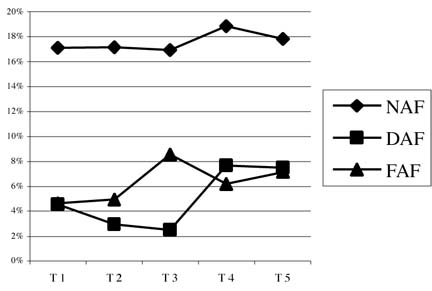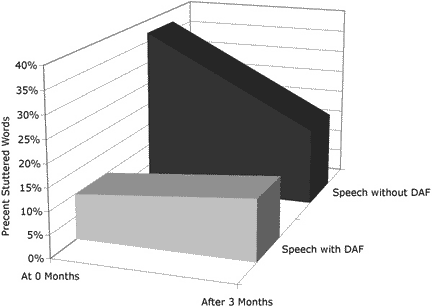Studies of Casa Futura Technologies Devices
Casa Futura Technologies altered auditory feedback (AAF) devices immediately reduce stuttering about 70%, without training, mental effort, or abnormally slow or abnormal-sounding speech. When combined with fluency shaping stuttering therapy (training the user to relax their breathing, relax their vocal folds, and slow their speaking rate by stretching vowels) the devices can nearly eliminate even severe stuttering.
Metaanalysis and Systematic Review
Altered auditory feedback and the treatment of stuttering: a review, by Michelle Lincoln, Ann Packman, and Mark Onslow, compared published studies of several devices. Journal of Fluency Disorders, 2006;31(2):71-89. doi: 10.1016/j.jfludis.2006.04.001. Epub 2006 Jun 5.
DAF Long-Term Carryover Fluency
Nine severe adult stutterers used Casa Futura Technologies School DAF devices for an average of thirty minutes per day (ten minutes reading aloud, ten minutes conversation with family member, ten minute telephone call). They received no speech therapy. After three months their stuttering had diminished 55% (when speaking without the devices). Van Borsel, J., Reunes, G., and Van den Bergh, N. (2003). “Delayed auditory feedback in the treatment of stuttering: clients as consumers,” International Journal of Language and Communication Disorders, 2003, Vol. 38, No. 2, 119-129. Device used: School DAF, Casa Futura Technologies.
A single-subject study with an eleven-year-old boy found that fourteen hours of structured therapy with mediated learning and a Casa Futura Technologies School DAF device reduced stuttering from 9% dysfluencies to 4.8% dysfluencies (when speaking without the device). One year later his stuttering was still 4.8% dysfluencies (47% reduction in stuttering). Another fourteen hours of similar treatment reduced his stuttering to 4.1% dysfluencies (55% reduction in stuttering). Radford, N., Tanguma, J., Gonzalez, M., Nericcio, M.A., Newman, D. “A Case Study of Mediated Learning, Delayed Auditory Feedback, and Motor Repatterning to Reduce Stuttering,” Perceptual and Motor Skills, 2005, 101, 63-71. Device used: School DAF, Casa Futura Technologies.
DAF and FAF Immediate Effects on Stuttering
Seven adult stutterers called businesses using a Casa Futura Technologies binaural (two ears) DAF/FAF anti-stuttering telephone device. Stuttering was reduced on average about 80%. Brenaut, L., Morrison, S., Kalinowski, J., Armson, J., Stuart, A. (1995). “Effect of Altered Auditory Feedback on Stuttering During Telephone Use.” Poster session, American Speech-Language Hearing Association convention, from Dalhousie University, Halifax, Nova Scotia, Canada, 1995. Device used: Desktop Fluency System, Casa Futura Technologies.
Nine adult stutterers called businesses in New York City using a Casa Futura Technologies binaural (two ears) DAF/FAF anti-stuttering telephone device. Stuttering was reduced on average about 60%. Zimmerman, S., Kalinowski, J., Stuart, A., Rastatter, M. (1997). “Effect of Altered Auditory Feedback on People Who Stutter During Scripted Telephone Conversations.” Journal of Speech, Language, and Hearing Research, Vol. 40, 1130-1134, October 1997. Device used: Desktop Fluency System, Casa Futura Technologies.
Eleven adults, from very mild to severe, used a Pocket Speech Lab under five conditions:
- Conversation with 100ms DAF and -1.0 octave FAF (max/max)
- Conversation with 50ms DAF and -0.6 octave FAF (min/min)
- Conversation with 50ms DAF and -1.0 octave FAF (min/max)
- Reading aloud with 100ms DAF and -1.0 octave FAF (max/max)
- Conversation with 110-Hz sine wave MAF
In oral reading, DAF/FAF reduced stuttering 62%. In conversations at the maximum settings DAF/FAF reduced stuttering 49%. In conversations when DAF and/or FAF were reduced the effectiveness reduced; the minimum settings reduced stuttering 27%. Michelle Lincoln, Ann Packman, Mark Onslow, Mark Jones, “An experimental investigation of the effect of AAF on the conversational speech of adults who stutter,” Journal of Speech, Language, and Hearing Research, October 2010, 53: 1122 – 1131. Device used: Pocket Speech Lab, Casa Futura Technologies.
Eight adult stutterers used SmallTalk devices for oral reading and spontaneous speech (16 tests). The device reduced stuttering in 14 tests. The other two tests found mild stuttering or no stuttering both with and without the device. In 7 of the 16 tests, no stuttering was heard when the device was used. DAF and FAF settings were not standard for all subjects; rather, best settings were selected for each subject. Heitmann, R., Bjornerud, B., Einarsen, A., Narmo, A., Kravik, K., Ingebrigtsen, A., Hovd, T. (2010). “DAF- og FAF-funkajonene i stammebehandling med utgangspunkt i SmallTalk.” Norsk Tidskrift for Logopedi, January 2010, 15-20. Device used: SmallTalk, Casa Futura Technologies.
Binaural (two ears) DAF reduced stuttering 71% and FAF reduced stuttering 64% in eleven adult female stutterers; DAF reduced stuttering 33% and FAF reduced stuttering 31% in eleven adult male stutterers. Grosser, J., Natke, U., Langefeld, S., & Kalveram, K. Th. (2001) Reduction in stuttering by delayed and frequency shifted auditory feedback: Effects of adaptation and sex differences. In H. G. Bosshardt, J. S. Yaruss & H. F. M. Peters (Eds.), Fluency Disorders: Theory, Research, Treatment and Self-help. Proceedings of the Third World Congress of Fluency Disorders in Nyborg, Denmark. Nijmegen: Nijmegen University Press, 422-426. Device used: Desktop Fluency System, Casa Futura Technologies.

Stuttering (left scale) while reading five text passages (bottom scale), in women. About 17% of words were stuttered without the device (NAF). Stuttered words with DAF or FAF varied between 2% and 8%.
Binaural (two ears) DAF reduced stuttering in all eight stutterers; FAF reduced stuttering in four of eight stutterers. Natke, U. (2000) Stotterreduktion unter verzögerter und frequenzverschobener auditiver Rückmeldung/Reduction of stuttering frequency using frequency-shifted and delayed auditory feedback. Folia Phoniatrica et Logopaedica, 52 (4), 151-159. Device used: Desktop Fluency System, Casa Futura Technologies.
A Casa Futura Technologies Pocket Speech Lab set at 75 ms DAF and -0.5 octaves FAF reduced stuttering on average 44%, for eight adults, in monologue speaking, without speech therapy. The device had greater relative effectiveness for severe stutterers. Antipova, E., Purdy, S., Blakeley, M., & Williams, S. (2008) “Effects of altered auditory feedback (AAF) on stuttering frequency during monologue speech production,” Journal of Fluency Disorders, 33:4, December 2008, 274-290.
A study of 30 adult stutterers compared the VoiceAmp and SmallTalk devices. The VoiceAmp was set at 50 ms DAF and 250 Hz addition, with a monaural miniature cellphone earset. The SmallTalk was set at 50 ms DAF and 0.4 octaves downshift, with a binaural full-size headset. Test conditions were 5 minutes reading aloud, 5 minutes monolog, and 10 minutes dialog in a quiet speech clinic. The overall results were that both devices reduced stuttering 34%. The frequency of disfluencies was reduced but there was no change in the duration of disfluencies. No change was found in speaking rate or articulatory rate. Both devices were more effective for blocks than for repetitions or prolongations. Both devices were effective for reading aloud, monologues, and dialogues. Both devices were more effective for moderate and severe stutterers and less effective for mild stutterers. Unger, J., Glück, C., & Cholewa, J. Immediate effects of AAF devices on the characteristics of stuttering: A clinical analysis. Journal of Fluency Disorders, 37 (2012) 122–134. Device used: SmallTalk, Casa Futura Technologies.
Compared To Other AAF Devices
A Casa Futura Technologies DAF/FAF device was more than twice as effective when compared to another company’s DAF/FAF anti-stuttering device. Hyde, L. (2003). “Comparison of the SpeechEasy and Casa Futura/Jabra fluency devices,” presentation to the Canadian Association of Persons who Stutter conference, August 2003. Device used: Pocket Fluency System, Casa Futura Technologies.
DAF and FAF Effects on Hypokinetic Dysarthria
Hypokinetic dysarthria is the speech disorder associated with Parkinson’s disease.
A six-month study of six men with Parkinson’s disease found that the SmallTalk improved speech in four subjects; two subjects were non-compliant for wearing the device and were removed from the study. No adaptation or “wearing off” of effectiveness was seen; however, no carryover fluency was seen after the devices were removed. Three participants purchased the devices at the conclusion of the study and continued to report benefits two years later; two of these men reported that the devices have allowed them to maintain gainful employment. The study was conducted by Stephen Grill, MD, PhD; Leslie S. Kessler, MA, CCC-SLP; and Nancy Pearl Solomon, PhD, CCC-SLP at the Parkinsons & Movement Disorders Center of Maryland and presented at a Motor Speech Disorders conference in March, 2010.
DAF and FAF Effects on Vocal Fold Activity of Stutterers
Langefeld, S., Natke, U., Donath, Th., & Kalveram, K. Th. (2001) Influence of public speaking on the control of vowel duration in stuttering and nonstuttering adults – preliminary results. In H. G. Bosshardt, J. S. Yaruss & H. F. M. Peters (Eds.), Fluency Disorders: Theory, Research, Treatment and Self-help. Proceedings of the Third World Congress of Fluency Disorders in Nyborg, Denmark. Nijmegen: Nijmegen University Press, 574-577. Device used: Desktop Fluency System, Casa Futura Technologies.
Natke, U., & Kalveram, K.Th. (2001) Fundamental frequency and vowel duration under frequency shifted auditory feedback in stuttering and nonstuttering adults. In H.-G. Bosshardt, J. S. Yaruss & H. F. M. Peters (Eds.), Fluency Disorders: Theory, Research, Treatment and Self-help. Proceedings of the Third World Congress of Fluency Disorders in Nyborg, Denmark. Nijmegen: Nijmegen University Press, 66-71. Device used: Desktop Fluency System, Casa Futura Technologies.
Natke, U., Grosser, J., & Kalveram, K.Th. (2001) Fluency, fundamental frequency, and speech rate under frequency shifted auditory feedback in stuttering and nonstuttering persons. Journal of Fluency Disorders, 26, 227-241. Device used: Desktop Fluency System, Casa Futura Technologies.
Natke, U. (2000a) Effekte unter modifizierter auditiver Rückmeldung: Sprechflüssigkeit, Phonationsdauer und Grundfrequenz bei stotternden und nichtstotternden Personen. In G. Lotzmann (Ed.), Selbstwahrnehmung und Fremdwahrnehmung bei Sprach-, Sprech-, Stimm- und Hörstörungen. Würzburg: Edition Bentheim, 166-176. Device used: Desktop Fluency System, Casa Futura Technologies.
Natke, U. (1999b) Die Kontrolle der Phonationsdauer bei stotternden und nichtstotternden Personen: Einfluss der Rückmeldelautstärke und Adaptation/The control of phonation duration in stuttering and nonstuttering people: Influence of feedback loudness and adaptation. Sprache – Stimme – Gehör, 23, 198-205. Device used: Desktop Fluency System, Casa Futura Technologies.
Phonological Complexity in Stutterers with AAF
Pendeliau-Verdurand, Marine (2015), dissertation on the effects of altered auditory feedback (AAF) on stutterers’ coarticulation and phonological complexity. Device used: SmallTalk, Casa Futura Technologies.
Vocal Frequency Effects of FAF on Non-Stutterers
Natke, U., Donath, Th.M., & Kalveram, K.Th. (2003) Control of voice fundamental frequency in speaking versus singing. Journal of the Acoustical Society of America, 113(3), 1587-1593. Device used: Desktop Fluency System, Casa Futura Technologies.
Donath, Th., Natke, U., Kalveram, K.Th. (2002) Effects of frequency-shifted auditory feedback on voice F0 contours in syllables. Journal of the Acoustical Society of America, 111(1), 357-366. Device used: Desktop Fluency System, Casa Futura Technologies.
Donath, Th., Natke, U., & Kalveram, K.Th. (2001) Magnitude and latency of fundamental frequency response within syllables under frequency shifted auditory feedback and public speaking. In B. Maassen, W. Hulstijn, R. D. Kent & P. H. H. M. Van Lieshout (Eds.), Speech Motor Control in Normal and Disordered Speech. Proceedings 4th International Speech Motor Conference. Nijmegen, The Netherlands: Uitgeverij Vantilt, 61-64. Device used: Desktop Fluency System, Casa Futura Technologies.
Natke, U., & Kalveram, K.Th. (2001b) Effects of frequency shifted auditory feedback on fundamental frequency in long stressed and unstressed syllables. Journal of Speech, Language, and Hearing Research, 44, 577-584. Device used: Desktop Fluency System, Casa Futura Technologies.

